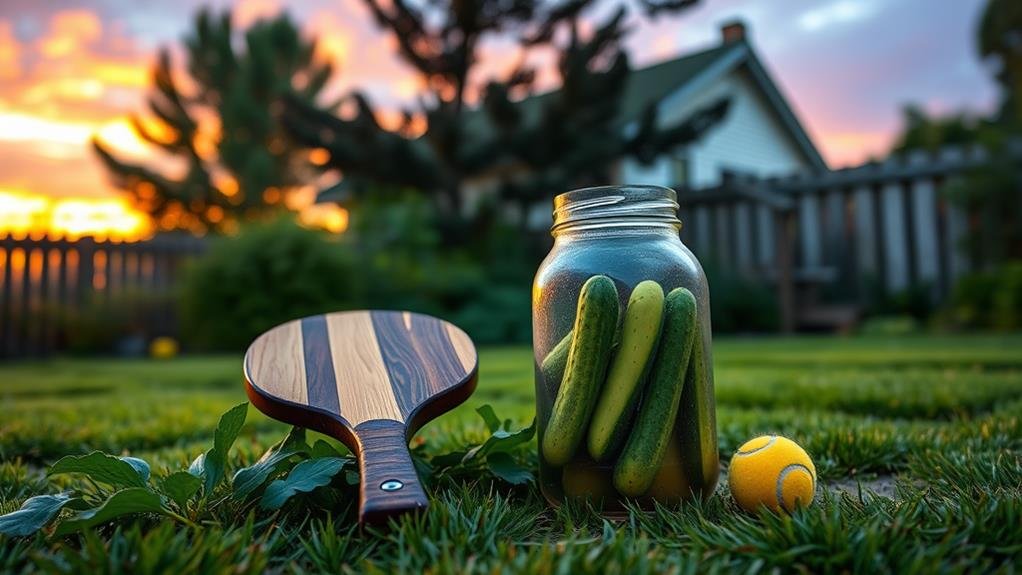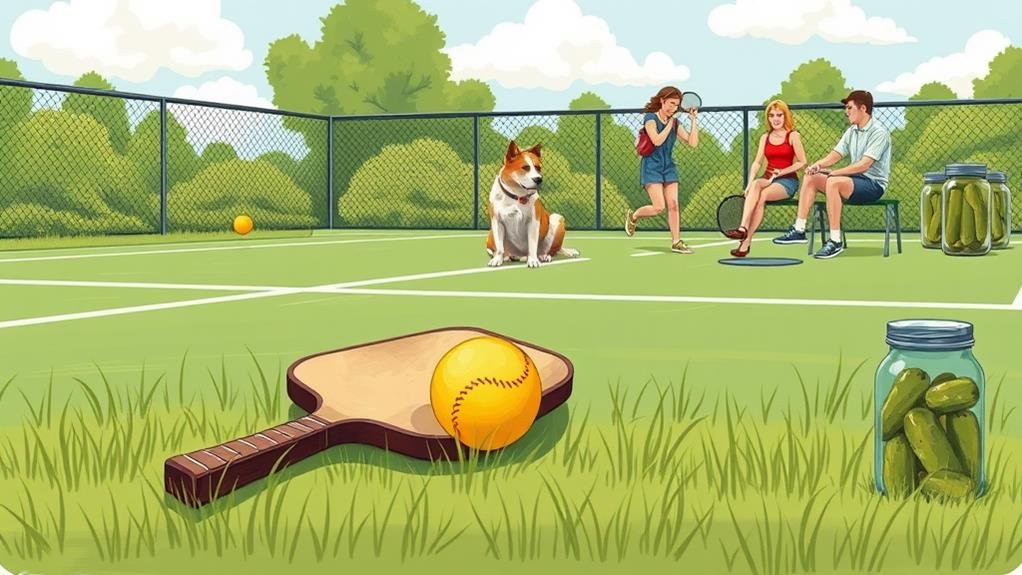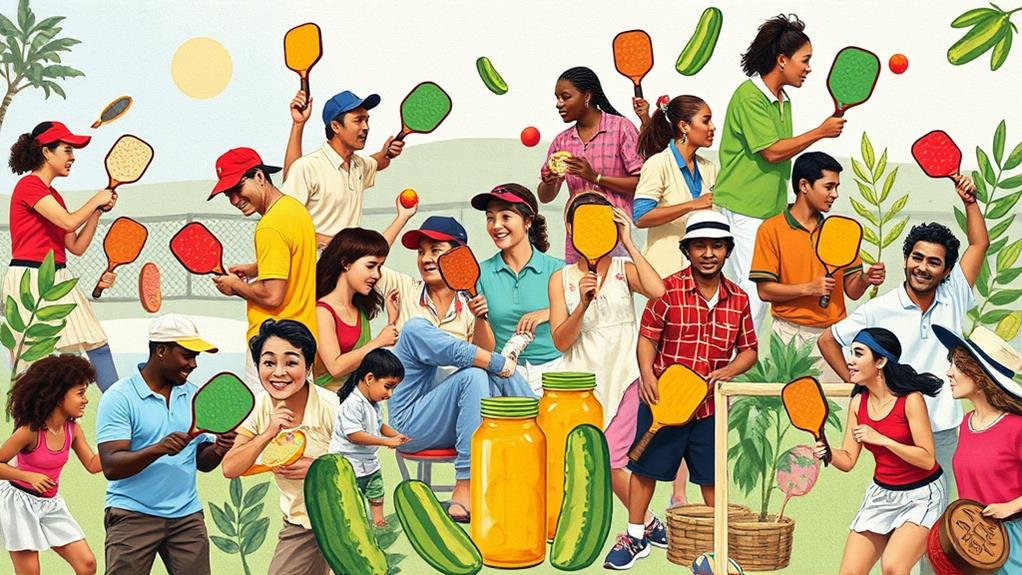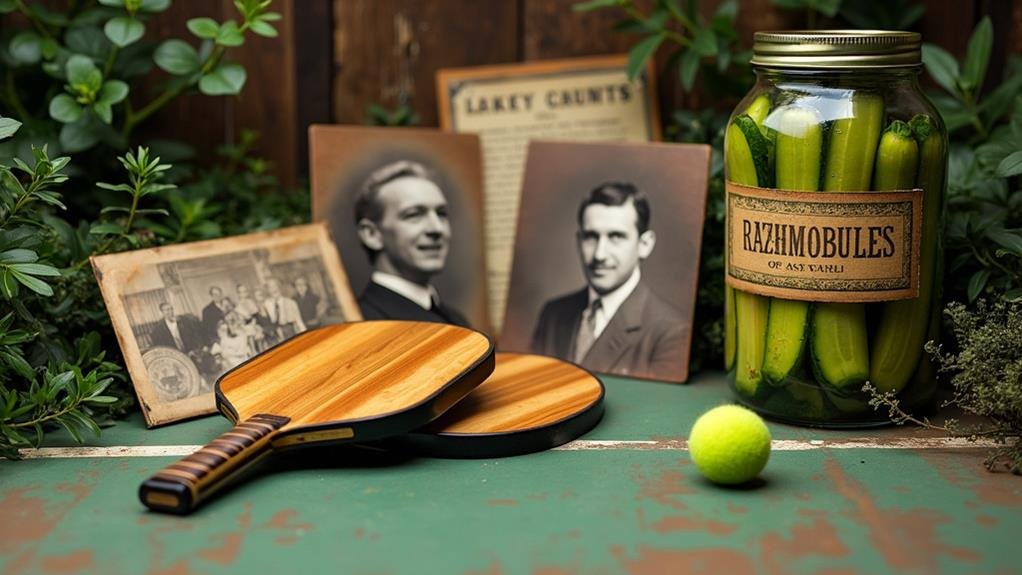Pickleball, created in 1965 on Bainbridge Island, got its name from a combination of playful anecdotes and historical references. A popular theory claims that the Pritchard family's dog, named Pickles, inspired the name. Others suggest it reflects a "pickle boat" concept—mixing leftover rowers, paralleling the sport's blend of tennis, badminton, and ping pong. Additionally, the name embodies the game's fun and inclusive nature, fostering community engagement. Understanding these origins and naming theories enriches the appreciation of this rapidly growing sport, and there's much more to uncover about its fascinating journey and impact on players.
Key Takeaways
- Pickleball was created in 1965 by Joel Pritchard, Bill Bell, and Barney McCallum on Bainbridge Island, Washington.
- The name "pickleball" is often attributed to the Pritchard family's dog, Pickles.
- Another theory suggests the name refers to the mix of different sports, similar to a "pickle boat" in rowing.
- The playful nature of the name reflects the sport's fun and accessible characteristics.
- Regional variations exist, with different locales presenting unique stories about the sport's name.
Origins of Pickleball

Have you ever wondered how a game that combines elements of tennis, badminton, and ping pong emerged? The origins of pickleball trace back to 1965, when Joel Pritchard, Bill Bell, and Barney McCallum sought to entertain their families on Bainbridge Island, Washington. They innovatively blended game mechanics from existing racquet sports, utilizing a perforated plastic ball and paddles, creating an accessible yet competitive experience.
This new game quickly attracted diverse player demographics, appealing to both young athletes and older adults seeking a social, low-impact sport.
As you delve deeper into its mechanics, you'll notice that pickleball emphasizes strategic positioning, agility, and teamwork, making it adaptable for various skill levels. The court size, smaller than a tennis court, encourages quick exchanges and fosters an engaging atmosphere.
Moreover, its simple rules and minimal equipment requirements have made it widely accessible, allowing communities across the U.S. to embrace this sport.
As pickleball continues to evolve, its origins remind us of a desire for innovation in recreational activities, encouraging players from all walks of life to participate and enjoy the game.
The First Game
The excitement of innovation sparked the first official game of pickleball in the summer of 1965, when Pritchard, Bell, and McCallum gathered their families to test out their newly created sport. This inaugural match took place on a makeshift court in Pritchard's backyard, utilizing a blend of badminton, tennis, and ping-pong elements.
With improvised paddles and a perforated plastic ball, they were eager to see how their game rules would hold up in practice. As you dive into that first match, you'd notice the trial-and-error nature of their approach. They quickly adapted the rules, focusing on simplicity and fun.
The court dimensions were determined on the fly, and the scoring system evolved to accommodate the players' skill levels. This flexibility not only enhanced the experience but also laid the groundwork for the structured rules that would follow.
The thrill of participation in that initial game ignited a passion for pickleball that would grow exponentially. It wasn't just about testing the sport; it was about fostering a community, leading to a legacy that continues to thrive.
That summer, innovation turned into an enduring social phenomenon.
Naming Theories

Several theories exist about how pickleball got its unique name, each offering a different perspective on the sport's origins. The most commonly cited theory suggests that the name derives from the family dog of one of the game's co-creators, which was named Pickles. However, others argue that the term "pickle" refers to the concept of "pickling," where various elements are mixed together, much like the fusion of tennis, badminton, and ping-pong that characterizes the game.
To better understand these naming conventions, consider the following table:
| Theory | Description | Popularity |
|---|---|---|
| Dog Named Pickles | The family pet inspired the game's name. | High |
| Pickling Concept | Represents mixing sports into one cohesive game. | Moderate |
| Pickle Boat | Refers to a term used for a boat carrying mixed crews. | Low |
| Playful Joke | A whimsical choice reflecting the sport's fun. | Moderate |
| Regional Variation | Different locales have their own stories. | Low |
These name origins reflect the playful and innovative spirit that surrounds pickleball, inviting players to enjoy both the game and its intriguing history.
The Pickleball Paddle
Exploring the design and functionality of the pickleball paddle reveals its crucial role in the game's dynamics and player performance. The choice of paddle materials significantly influences how you interact with the ball.
Modern paddles are typically constructed from lightweight composites, such as fiberglass, carbon fiber, and polymer, which enhance durability and power. These materials allow for varied textures and surfaces, contributing to better control and spin.
In terms of paddle design, you'll notice variations in shape, weight, and grip size. Wider paddles, for instance, offer a larger sweet spot, making it easier for you to connect with the ball. Conversely, thinner paddles provide more maneuverability, allowing for quicker reactions during fast-paced exchanges.
Additionally, the grip design is paramount; an ergonomic grip not only boosts comfort but also improves your control during play.
As you explore different paddles, consider how these innovations can elevate your game. The right combination of materials and design can transform your performance, making the paddle an essential tool for both beginners and seasoned players alike.
The Role of Joan Pritchard

While many players have contributed to the growth of pickleball, Joan Pritchard stands out for her pivotal role in popularizing the sport. Her influence is apparent not just in her active participation but also in her efforts to foster community engagement through tournaments and events. Pritchard's anecdotes about introducing pickleball to new players reflect her passion for the game and highlight the sport's social aspect.
Here's a brief overview of her contributions:
| Contribution | Description | Impact |
|---|---|---|
| Community Tournaments | Organized local and regional events | Increased player participation |
| Coaching Clinics | Provided instruction and mentorship | Developed new talent and interest |
| Promotion of Inclusivity | Advocated for diverse player representation | Enhanced community and accessibility |
| Storytelling | Shared personal experiences and lessons learned | Inspired newcomers and veterans alike |
| Network Building | Fostered connections among players and sponsors | Strengthened the sport's growth potential |
Joan Pritchard's influence continues to resonate, proving that pickleball is more than just a game; it's a vibrant community shaped by passionate individuals.
The Pickle Boat Connection
The connection between pickleball and its whimsical name—often attributed to the term "pickle boat"—offers an intriguing glimpse into the sport's origins. The term refers to a boat in competitive rowing that's crewed by leftover rowers from other teams, creating a unique blend. This eclectic mix mirrors the essence of pickleball, which combines elements from various racquet sports.
Consider the imagery that the term evokes:
- Rowers from different backgrounds, uniting in a shared goal
- The playful chaos of a hodgepodge crew
- A spirited competition that thrives on diversity
- An innovative approach, breaking traditional molds
Just as the pickle boat embraces a variety of players, pickleball itself welcomes individuals of all ages and skills.
The sport's creators, including Joel Pritchard and his friends, aimed to merge different elements from tennis, badminton, and ping-pong, resulting in a game that resonates with the same spirit as the pickle boat.
This connection emphasizes not just the sport's playful nature but also its roots in collaboration and creativity, making pickleball a truly innovative pastime that continues to grow in popularity.
Cultural Impact of the Name

Often overlooked, the cultural impact of the name "pickleball" extends far beyond its whimsical origins. This unique name carries significant cultural symbolism, representing a blend of fun, community, and accessibility. Its playful connotation invites curiosity, drawing people from diverse backgrounds to engage with the sport.
Unlike more traditional sports, which often evoke a sense of elitism or exclusivity, pickleball's name fosters a welcoming environment that encourages participation.
The cultural significance of pickleball lies in its ability to bridge generational gaps, creating a shared experience for players of all ages. The name itself sparks conversation, often leading to the sharing of stories and experiences, which strengthens community bonds.
Moreover, as the sport gains popularity, the name has become a symbol of innovation in recreational activities, challenging conventional perceptions of sport and play.
In a world increasingly focused on inclusivity and social connection, pickleball's name serves as a beacon, inviting everyone to partake in its dynamic and engaging atmosphere.
Ultimately, the cultural impact of "pickleball" transcends mere nomenclature; it embodies a movement towards a more interconnected and playful society.
Evolution of the Game
Transformation defines the evolution of pickleball, as it has adapted and grown since its inception in 1965. Initially a simple backyard pastime, the game has undergone significant changes in game mechanics and rule variations, making it more dynamic and appealing.
You'll notice how these elements have contributed to its current form:
- Court Size: Originally played on a smaller court, it has expanded to accommodate different skill levels.
- Racket Design: The shift from wooden paddles to modern composite materials has enhanced performance and control.
- Scoring Systems: Early games adopted traditional scoring, but now, rally scoring allows for faster-paced play.
- Player Strategies: As techniques evolve, players have developed more sophisticated strategies, emphasizing teamwork and agility.
These adaptations demonstrate how pickleball has responded to player feedback and market demands, creating a vibrant and engaging sport.
The ongoing adjustments to game mechanics and rule variations reflect a community dedicated to innovation, ensuring that pickleball not only survives but thrives in an ever-changing sports landscape.
Whether you're a casual player or aspiring pro, you'll appreciate the game's progression and the excitement it brings.
Popularity Surge

Pickleball's recent popularity surge reflects a perfect storm of factors that have captivated players of all ages. The sport's accessibility is a key driver, allowing newcomers to grasp the rules quickly and engage in friendly competition. As more communities embrace pickleball, local courts pop up, fostering community engagement and encouraging players to connect through shared experiences.
Moreover, celebrity endorsements have played a pivotal role in elevating pickleball's profile. When high-profile athletes and influencers showcase their love for the game, they attract attention from their vast followings, enticing a diverse demographic to give pickleball a try. This cascading effect has created a buzz, with social media amplifying the sport's visibility and fostering a sense of belonging among players.
The rise in organized tournaments is another factor contributing to its popularity. These events not only provide competitive opportunities but also cultivate a sense of camaraderie and excitement within the pickleball community.
As people seek innovative ways to stay active and socially engaged, pickleball stands out as a vibrant choice, blending athleticism with fun. This perfect mix has solidified its status as a contemporary favorite, appealing to both seasoned athletes and casual players alike.
Pickleball Today
The landscape of pickleball today is marked by an unprecedented blend of growth, innovation, and community engagement. With a rapidly expanding player base, the sport has attracted diverse pickleball demographics, ranging from young enthusiasts to active seniors. This shift reflects not only the sport's accessibility but also its appeal as a social activity.
As you delve into the current scene, you'll notice:
- Thriving local clubs fostering camaraderie and competition.
- National pickleball tournaments showcasing elite talent and skills.
- Innovative equipment designed to enhance performance and enjoyment.
- Online platforms facilitating virtual play and community-building.
The rise of pickleball tournaments has energized the sport, creating pathways for amateur players to compete at higher levels. These events not only highlight athletic prowess but also serve as gatherings that strengthen community ties.
As pickleball continues to evolve, innovations in training methods and technology promise to enhance gameplay and broaden its appeal further.
Your involvement in this burgeoning movement not only connects you to a vibrant community but also positions you at the forefront of a transformative sporting phenomenon. Embrace the future of pickleball; it's just getting started!
Conclusion
In conclusion, the name "pickleball" serves as a delightful reminder of the sport's quirky origins and its evolution into a beloved pastime. Whether you choose to believe it was named after a dog or a term for a mixed-up game, one thing's clear: pickleball has woven itself into the fabric of recreational culture. As its popularity surges, it stands as a testament to how a simple game can pickle together community, fun, and competition in unexpected ways.

